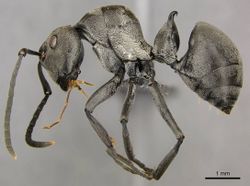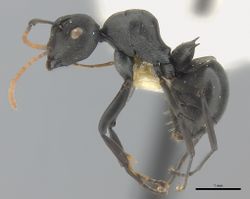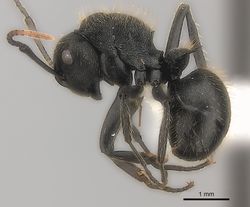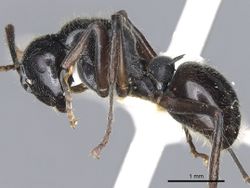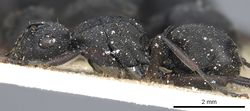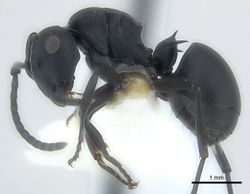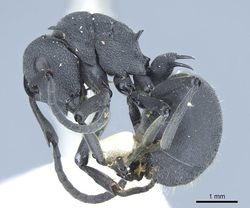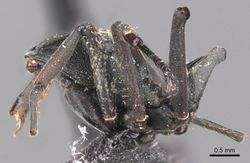Key to Afrotropical Polyrhachis species (Bolton 1973, OUTDATED)
Bolton (1973)[1].
This key is outdated. For the valid one check: Key to Afrotropical Polyrhachis species, based on the 2016 revision and key by Rigato.
1
- Clypeus with a shallow, rectangular lobe flanked by a pair of denticles or teeth. Eyes situated well up on the head, usually not breaking the outline of the sides in full face view. Alitrunk broad and foreshortened, with a swollen appearance in dorsal view, usually not more than 1:1 times longer than broad. Pronotum always marginate, at least for part of its length but either the mesonotum or propodeum or both not marginate. Propodeum unarmed, the declivity extremely deep .....2
- Clypeus either arcuate and entire or with a truncated medial lobe. Eyes breaking the outline of the sides in full face view except when the eyes are flat. Alitrunk without a foreshortened and swollen appearance in dorsal view, usually more than 1:3 times longer than broad. Alitrunk usually either marginate or totally without lateral margination throughout its length. If partially marginate then the propodeum is armed with spines, teeth, tubercles or raised ridges.....6
2
return to couplet .....1
- Petiole armed with two spines or teeth .....3
- Petiole armed with four spines or teeth .....4
3
return to couplet .....2
- Propodeum without a posterior transverse margination separating the dorsum from the declivity. Petiole dorsolaterally with two long spines, curved backwards and somewhat outwards at their apices, so that the petiole is lyre-shaped …..Polyrhachis curta
- Propodeum with a weak posterior transverse margination separating the dorsum from the declivity. Petiole laterally with a pair of small triangular teeth…..Polyrhachis lestoni
4
return to couplet .....2
- Propodeum marginate laterally and posteriorly, so that the dorsum is separated from the sides and declivity .....5
- Propodeum not at all marginate, so that the dorsum rounds into the sides and declivity without interruption …..Polyrhachis alexisi
5
return to couplet .....4
- In dorsal view the sides of the propodeum projecting strongly beyond the lateral marginations so that the total width of the propodeum is notably greater than the width between the marginations. Sides of head in front of the eye concave in full face view…..Polyrhachis latharis
- In dorsal view the sides of the propodeum hardly projecting beyond the lateral marginations so that the total width of the propodeum is bounded, at least posteriorly by the marginations. Sides of head in front of the eye straight in full face view…..Polyrhachis limitis
6
return to couplet .....1
- Pronotum not at all marginate, the dorsum curving smoothly and without interruption into the sides .....7
- Pronotum marginate at least for part of its length, usually throughout its entire length. Margination present as a raised or projected flange, a ridge, or an acute angle separating the dorsum from the sides .....16
7
return to couplet .....6
- Eyes flat and somewhat sunk into the surface of the head…..Polyrhachis platyomma
- Eyes convex, not sunk into the surface of the head.....8
8
return to couplet .....7
- Metanotal groove broad and deeply impressed. Propodeum armed with a pair of long upcurved spines, as long as or longer than those of the pronotum. Petiole with four long, back curved spines. Dorsum of alitrunk with numerous stout, usually yellow hairs .....9
- Metanotal groove weakly developed or absent. Propodeum unarmed or with a pair of tubercles, teeth or ridges which are notable smaller than those of the pronotum. Petiole with a dorsal pair of spines and a lateral pair of teeth or shorter spines. Hairs on dorsum of alitrunk fine or absent .....10
9
return to couplet .....8
- Promesonotal suture broad and deeply impressed. Propodeum without a median tuberculiform prominence between the spines…..Polyrhachis monista
- Promesonotal suture narrow, not impressed. Propodeum with a median tuberculiform prominence between the spines…..Polyrhachis spitteleri
10
return to couplet .....8
- Antennal scapes or dorsum of alitrunk or both with erect hairs. Mesoscutellum not visible on dorsum of alitrunk .....11
- Antennal scapes and dorsum of alitrunk without erect hairs. Mesoscutellum present on dorsum of alitrunk…..Polyrhachis gamaii
11
return to couplet .....10
- Pronotal dorsum sculptured, armed with a pair of distinct spines.....12
- Pronotal dorsum smooth and polished, unsculptured apart from pits from which hairs arise, armed with a pair of small or minute teeth or tubercles .....15
12
return to couplet .....11
- Propodeum armed posteriorly with a pair of transverse ridges separating the dorsum from the declivity; the ridges not meeting medially .....13
- Propodeum armed posteriorly with a pair of short, upcurved teeth, between which the dorsum curves into the declivity .....14
13
return to couplet .....12
- Median portion of clypeus projecting anteriorly as a truncated rectangular lobe. Relatively more slender species. CI 73, HW 1.00, PW 0.89 …..Polyrhachis volkarti
- Median portion of clypeus arcuate and entire, not projecting as a truncated rectangular lobe. Relatively more stout species. CI>75, HW>1.20, PW >1.00…..Polyrhachis lanuginosa
14
return to couplet .....12
- More than 30 erect hairs on each antennal scape. Dorsal surfaces of mesonotum and propodeum with a disorganised rugulation or a rugoretiulum; pubescence masking alitrunk sculpturation at least in part. Larger (TL 6.1 or more) relatively more thickset (PW 1.40 or more) species …..Polyrhachis revoili
- Less than 10 erect hairs on each antennal scape (usually none). Dorsal surfaces of mesonotum and propodeum sharply longitudinally rugose; pubescence not masking alitrunk sculpturation. Smaller (TL 6.1 or less) relatively more slender (PW 1.26 or less) species …..Polyrhachis weissi
15
return to couplet .....11
- Head unsculptured, with a short, longitudinal groove terminating in a pit like depression posteriorly; this structure situated close to the external margin of the antennal insertion. Sutures of the alitrunk present on dorsum but poorly developed …..Polyrhachis braxa
- Head sculptured, without a groove and pit as described above. Dorsum of alitrunk without sutures .....Polyrhachis khepra
16
return to couplet .....6
- Metanotal groove represented only by a line or an indistinct scoring across the dorsum of the alitrunk, which may fail to break the sculpturation; Metanotal groove never impressed, sometimes completely absent .....17
- Metanotal groove distinct, broad and always impressed; profile often with the appearance of a V or U shaped trench separating the mesonotum from the propodeum .....26
17
return to couplet .....16
- Antennal scapes with numerous erect hairs out at right-angles to the long axis of the shaft .....18
- Antennal scapes without erect hairs out at right-angles to the long axis of the shaft (A few at the extreme apex may be present, projecting in the same direction as the long axis of the scape .....20
18
return to couplet .....17
- Propodeum with a pair of transverse ridges separating the dorsum from the declivity. The ridges fail to meet medially and a small but distinct gap is present…..Polyrhachis otleti
- Propodeum with a pair of teeth or minute tubercles, between which the dorsum curves into over its entire width .....19
19
return to couplet .....18
- Sculpturation of head in space between eye and frontal carina regularly, finely longitudinally striate-rugose. Dorsum of mesonotum separated from sides by an obtuse angle. Larger species, TL 7.0 mm or more, HL>1.50 mm, PW 1.0 mm…..Polyrhachis transiens
- Sculpturation of head in space between eye and frontal carina an irregular rugo-reticulum, the spaces between which are finely reticulate-punctuate. Dorsum of mesonotum rounding into sides without interruption. Smaller species, TL <5.0 mm, HL<1.30 mm, PW<1.0 mm…..Polyrhachis regesa
20
return to couplet .....17
- Propodeum not marginate laterally; pronotum very weakly marginate for about half its length. Sculpturation everywhere a fine superficial reticulation or reticulate-punctuation …..Polyrhachis aenescens
- Propodeum marginate laterally; pronotum marginate throughout its length. Sculpturation of alitrunk basically a fine reticulate-punctuation overlaid by longitudinal rugae or a loose rugoreticulum .....21
21
return to couplet .....20
- Propodeum with a transverse ridge running between the spines or teeth and separating the dorsum from the declivity, the ridge often raised into a tooth or tubercle medially .....22
- Propodeum without a transverse ridge running between the spines or teeth, the dorsum passing through an angle or curving directly into the declivity. Median tooth or tubercle always absent .....25
22
return to couplet .....21
- Gaster finely longitudinally striate …..Polyrhachis arnoldi
- Gaster finely reticulate-punctuate .....23
23
return to couplet .....22
- Apex of antennal scape suddenly broadened, hood like in dorsal view, concealing the base of the first funicular segment, which is strongly dorsoventrally flattened basally. Eyes usually quite flat, occasionally weakly convex…..Polyrhachis viscosa
- Apex of antennal scape not suddenly broadened, not hood like nor concealing the base of the first funicular segment, this segment not strongly dorsoventrally flattened basally. Eyes convex.....24
24
return to couplet .....23
- Propodeum with only a transverse ridge running between the spines; the ridge may be arched medially but no tooth or tubercle is present. Propodeal spines out-curved directed posterolaterally, only very slightly upcurved…..Polyrhachis spinicola
- Propodeum with a transverse ridge running between the spines which is raised medially into a tooth or tubercle. Propodeal spines directed upwards and upcurved…..Polyrhachis cubaensis
25
return to couplet .....21
- Petiole with a single pair of well-developed spines situated at the dorsolateral corners. On the dorsal margin between these spines are a pair of small teeth or tubercles …..Polyrhachis nigrita
- Petiole with two pairs of well developed spines; the dorsal pair somewhat longer than the lateral…..Polyrhachis durbanensis
26
return to couplet .....16
27
return to couplet .....26
- Petiolar spines subparallel, strongly hooked backwards at their apices. Clypeus carinate; gastral pubescence usually golden…..Polyrhachis laboriosa
- Petiolar spines divergent, curving posteriorly along their length but not hooked apically (Text-fig. 23). Clypeus not carinate; gastral pubescence not golden, usually grey…..Polyrhachis wellmani
28
return to couplet .....26
- Petiole with six spines or teeth, the smallest pair situated behind the lateral pair of spines…..Polyrhachis decemdentata
- Petiole with four spines or teeth of variable configuration .....29
29
return to couplet .....28
- Pronotal dorsum without erect hairs .....30
- Pronotal dorsum with erect hairs .....36
30
return to couplet .....29
- Dorsum of head with a pair of erect hairs situated on a level with the posterior margins of the eyes. If the hairs have been lost, then the site of their original insertion is marked by a pair of distinct pits .....31
- Dorsum of head without erect hairs; no hairs nor pits marking the former insertions of hairs present on the dorsum on a level with the posterior margins of the eyes .....32
31
return to couplet .....30
- Anterior clypeal margin with a small, shallow impression or notch medially. In dorsal view the propodeal marginations somewhat convex in outline and gradually diverging posteriorly to the propodeal teeth. Antennal scapes relatively extremely long (SI 181)…..Polyrhachis decellei
- Anterior clypeal margin arcuate and entire, without a shallow median impression. In dorsal view the propodeal marginations convex in outline, broadest at about the midlength of the segment and converging anteriorly to the metanotal groove and posteriorly to the propodeal tooth. Antennal scapes relatively much shorter (SI 159)…..Polyrhachis esarata
32
return to couplet .....30
- Head, body and appendages covered with a very dense, silvery pubescence. Pronotal spines long; in lateral view directed downwards and forwards, somewhat downcurved. Large species, HL>2.00, HW> 1.55…..Polyrhachis schlueteri
- Head, body and appendages usually with sparse pubescence; if dense then the pubescence is not silvery in colour. Pronotal spines long or short, but in lateral view not directed downwards and forwards, nor downcurved. Smaller species. HL<2.00, HW<1.45.....33
33
return to couplet .....32
- In posterior view the side of the head at the ventral margin of the eye projecting laterally below the eye and forming a shield or blinder. In side view the ventral margin appearing concave, so that the eye is reniform. In full-face view, sides of head in front of eyes noticeably concave. Larger species with relatively long antennae. HL 1.85 or more, SI > 170…..Polyrhachis concava
- In posterior view the side of the head at the ventral margin of the eye not projecting below the eye. In side view the ventral margin convex to shallowly concave. In full-face View, sides of head in front of the eyes varying from more or less straight to convex. Smaller species with relatively short antennae, HL< 1.80,
SI < 155.....34
34
return to couplet .....33
- Dorsum of pronotum strongly transversely concave, the lateral marginations projecting as raised flanges…..Polyrhachis aerope
- Dorsum of pronotum very shallowly concave to transversely convex, the lateral marginations not projecting as raised flanges .....35
35
return to couplet .....34
- Sculpturation of head a fine, dense, reticulate-puncturation. On the sides of the head below and in front of the eye, and on the gena between the eye and the posterior clypeal margin with numerous more distinct pits, usually arranged in groups of three or four. Larger species, HL> 1.60…..Polyrhachis alluaudi
- Sculpturation of head a fine, dense, reticulation; the sides of the head below and in front of the eye, and the gena between the eye and the posterior clypeal margin with the same sculpturation as the dorsum. Smaller species, HL < 1.30…..Polyrhachis rufipalpis
36
return to couplet .....29
- Lateral pair of petiolar spines as long as, or longer than the dorsals .....37
- Lateral pair of petiolar spines short, always notably shorter than the dorsals, may be reduced to a pair of acute teeth .....41
37
return to couplet .....36
- Antennal scapes with numerous erect hairs ˜projecting from the shaft…..Polyrhachis asomaningi
- Antennal scapes without erect hairs projecting from the shaft .....38
38
return to couplet .....37
- First gastral tergite finely longitudinally striate-rugose, with numerous small punctures between the rugae…..Polyrhachis phidias
- First gastral tergite finely superficially reticulate or reticulate-punctate .....39
39
return to couplet .....38
- Lateral pair of petiolar spines enormously developed, many times larger than the dorsals, which are reduced to a pair of short spines…..Polyrhachis cornuta
- Lateral pair of petiolar spines not greatly developed; the dorsals as long as, or only a little shorter than the laterals .....40
40
return to couplet .....39
- Face with a short, longitudinal, shallow groove terminating in a depression posteriorly; situated close to the outer margin of the antennal socket. Dorsum of propodeum extremely finely and densely longitudinally striate…..Polyrhachis lauta
- Face without a short, longitudinal, shallow groove terminating in a depression posteriorly. Dorsurn of propodeum coarsely and distinctly, transversely striate…..Polyrhachis fissa
41
return to couplet .....36
- Propodeum not marginate. Entire body very deeply and regularly striate, the spaces between the striae strongly convex, giving a ploughed appearance. This sculpturation V-shaped on the propodeum, longitudinal on head and rest of dorsal alitrunk…..Polyrhachis sulcata
- Propodeum marginate. Sculpturation not as above; if striate then finely so, not V-shaped on propodeum .....42
42
return to couplet .....41
- Dorsum of propodeum separated from decliivty by a strongly arched transverse, raised ridge running between the spines. First gastral tergite reticulate-punctate, overlaid on the basal half by a fine, dense, longitudinal rugulation…..Polyrhachis latispina
- Dorsum of propodeum not separated from declivity by a transverse ridge, the two surfaces confluent. First gastral tergite usually reticulate or reticulate-punctate, more rarely rugose .....43
43
return to couplet .....42
- Dorsum of alitrunk with erect hairs present only on the pronotum. Side of head between ventral border of eye and ventrolateral margin without erect hairs. Gaster highly polished, with a very fine, superficial reticulation …..Polyrhachis gagates
- Dorsum of alitrunk with erect hairs present on all segments. Side of head between ventral border of eye and ventrolateral margin with erect hairs. Gaster usually dull, with a fine reticulate-punctate sculpturation, or sculpturation hidden by pubescence .....44
44
return to couplet .....43
- Pubescence abundant everywhere, hiding the sculpturation of the dorsal alitrunk and gaster, at least in part; often silvery or golden in colour on part or all of the body. Relatively broader, more thickset species, HW>2.3, CI>82, PW>2.0 .....45
- Pubescence sparse, not hiding the sculpturation of the alitrunk or gaster, usually greyish in colour. Relatively narrower, more slender species, HW<2.3, CI 80 or less, PW<2.0 …..Polyrhachis schistacea
45
return to couplet .....44
- Lateral margination of alitrunk, especially pronotum, usually extended as a raised flange; the alitrunk somewhat concave dorsally between the marginations. Pubescence usually with a golden, brassy or bronze tinge on the alitrunk, gaster, or both. Erect hairs usually yellowish, not sinuate. Head with longitudinal rugulations which are also visible on the pronotal dorsum, especially at the bases of the spines. Eyes convex …..Polyrhachis militaris
- Lateral margination of alitrunk not extended as a raised flange, the alitrunk flat to weakly convex dorsally. Pubescence long, everywhere with a silvery tinge. Erect hairs abundant, silver-grey, sinuate or curved. Sculpturation everywhere, beneath the pubescence, of a fine, superficial reticulation. Eyes flat to weakly convex…..Polyrhachis medusa
References
<references>

